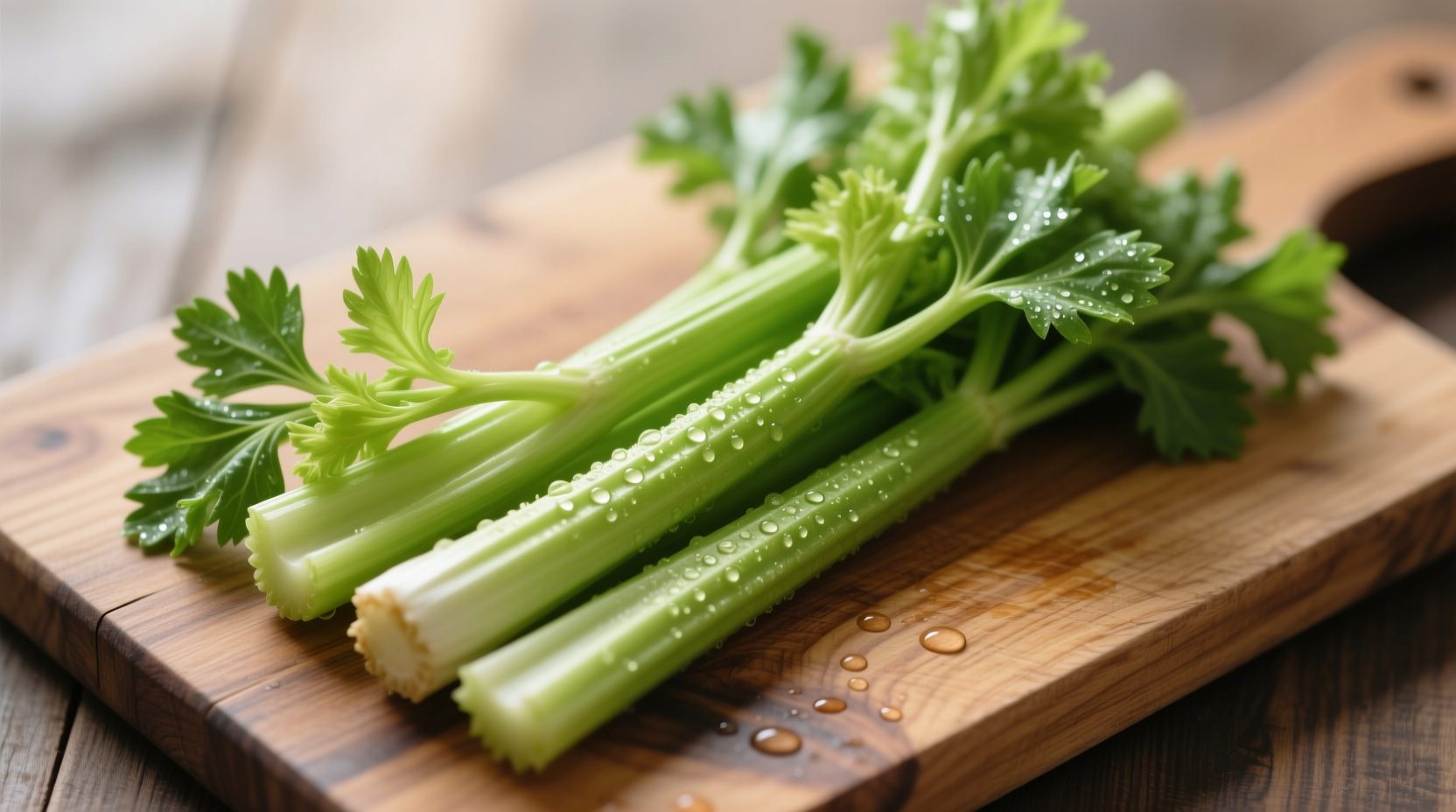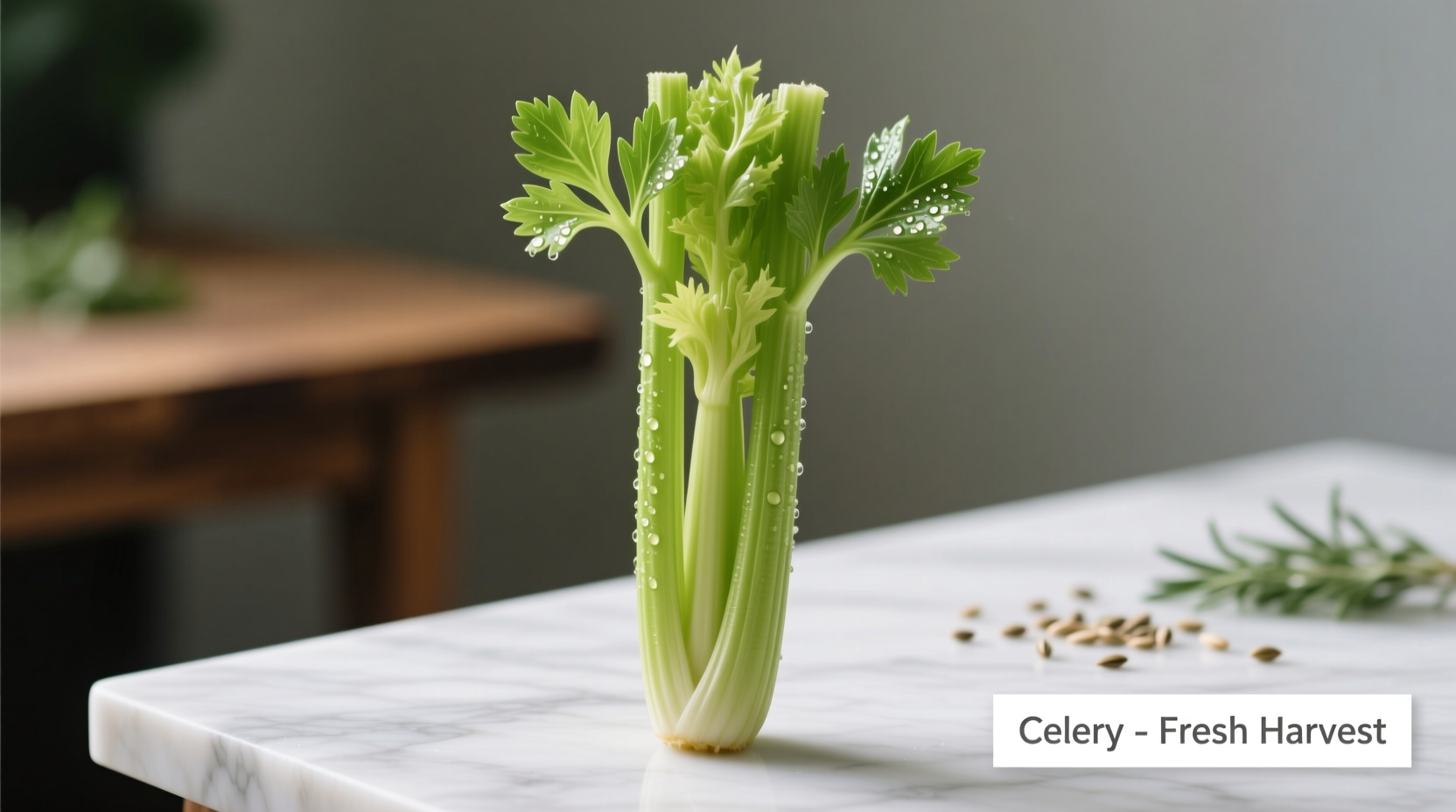When you reach for that crisp, green stalk in your refrigerator, you're grabbing one of nature's most underrated nutritional powerhouses. Beyond its role as a crunchy snack or soup base, celery delivers surprising health advantages and culinary versatility that deserve your attention.
What Exactly Is Celery?
Celery belongs to the Apiaceae family, which includes carrots, parsley, and fennel. The variety most commonly consumed is Apium graveolens var. dulce, featuring the familiar long, fibrous stalks we recognize. Less common varieties include leaf celery (popular in Asian cuisine) and celeriac (celery root), which features a bulbous root instead of prominent stalks.
| Variety | Appearance | Primary Use | Flavor Profile |
|---|---|---|---|
| Common Stalk Celery | Long green stalks with leaves | Raw consumption, soups, stocks | Mild, slightly salty, refreshing |
| Leaf Celery | Smaller stalks, abundant leaves | Asian cuisine, seasoning | Stronger, more aromatic |
| Celeriac | Knobby brown root vegetable | Root vegetable substitute | Earthy, nutty, celery-like |
This fact对照 table illustrates the key differences between celery varieties, helping you select the right type for your culinary needs. While common stalk celery dominates Western markets, leaf celery offers more intense flavor preferred in many Asian dishes, and celeriac provides a unique root vegetable option.
The Evolution of Celery Through History
Celery's journey from wild marsh plant to kitchen staple spans millennia. Unlike many vegetables bred for sweetness, celery was originally cultivated for medicinal purposes. Understanding this timeline reveals why celery remains relevant in modern nutrition:
- 850 BCE: First documented medicinal use in ancient Greece, where it treated ailments from arthritis to digestive issues
- 16th century: Italian gardeners began selective breeding, transforming bitter wild celery into the milder variety we know today
- 1700s: French and English growers developed distinct varieties, with England favoring the leafy type and France cultivating stalk celery
- 1800s: American settlers introduced celery to North America, where it became popular in Victorian-era cuisine
- 1920s: The development of the Pascal celery variety created the familiar crisp, mild stalks dominant in modern markets
- Present day: Celery ranks among the top 20 most-consumed vegetables in the United States according to USDA data
This historical context explains celery's dual identity as both food and medicine. Ancient physicians like Hippocrates prescribed celery for pain relief, while modern research validates some traditional uses through scientific analysis of its bioactive compounds.
Nutritional Powerhouse: What Science Says
Don't let celery's low calorie count fool you—this vegetable packs a surprising nutritional punch. According to USDA FoodData Central, one cup (101g) of chopped celery delivers:
- 32% of your daily vitamin K requirement
- 5% of vitamin C
- 9% of potassium
- 2 grams of dietary fiber
- Only 16 calories
Recent research published in the Journal of Agricultural and Food Chemistry identified over 25 different antioxidant compounds in celery, including flavonoids like apigenin and luteolin. These compounds demonstrate potential anti-inflammatory effects that may help reduce oxidative stress in the body.
When considering how to maximize these benefits, remember that cooking methods affect nutrient retention. Steaming preserves more antioxidants than boiling, while consuming celery raw provides the highest fiber content.
Culinary Applications: Beyond the Snack Plate
Celery's culinary versatility extends far beyond the classic peanut butter pairing. Professional chefs leverage its unique properties in several strategic ways:
Building Flavor Foundations
The "holy trinity" of mirepoix (celery, carrots, and onions) forms the flavor base for countless soups, stews, and sauces. When sautéed slowly in fat, celery releases natural glutamates that enhance umami flavors throughout a dish. For maximum impact, chop celery uniformly with other aromatics to ensure even cooking.
Texture and Hydration
Celery's high water content (95%) makes it ideal for adding moisture without diluting flavors. Try these techniques:
- Add finely diced celery to meatloaf or burgers for juiciness
- Blend celery into smoothies for hydration without strong flavor
- Use celery leaves as a fresh herb alternative in salads
Unexpected Flavor Pairings
While celery complements traditional savory dishes, innovative chefs are discovering surprising pairings:
- Sweet applications: Poached celery stalks with pears and honey create an elegant side dish
- Cocktail ingredient: Muddled celery adds complexity to Bloody Marys and gin cocktails
- Pickling: Quick-pickled celery maintains crunch while adding tangy dimension

Practical Selection and Storage Guide
Maximizing celery's shelf life and flavor requires proper handling techniques. Follow these evidence-based recommendations:
Selecting Quality Celery
When choosing celery at the market, look for:
- Vibrant green color without yellowing or browning
- Firm, crisp stalks that snap cleanly when bent
- Intact leaves with minimal wilting
- Heavy weight relative to size (indicates hydration)
Storage Techniques That Work
Contrary to popular belief, storing celery in its original plastic wrap leads to faster deterioration. Research from the University of California's Agriculture Department shows these methods extend freshness:
- Aluminum foil method: Wrap stalks loosely in foil to regulate ethylene gas
- Water bath storage: Submerge cut ends in water in the refrigerator (change water every 2 days)
- Container method: Store in airtight container with slightly damp paper towel
Properly stored, celery maintains crispness for 2-3 weeks rather than the typical 5-7 days. For longer preservation, chop and freeze celery for cooking applications (though texture changes make it unsuitable for raw consumption after freezing).
Contextual Considerations for Different Uses
Understanding when to use specific celery varieties prevents culinary disappointment. These context boundaries help you make informed choices:
- Raw consumption: Choose Pascal variety with crisp, pale green stalks; avoid yellowing or stringy specimens
- Cooking applications: Older or slightly limp celery works well in soups and stocks where texture matters less
- Leaf celery substitution: Use regular celery leaves plus a pinch of celery seed when leaf celery isn't available
- Celeriac alternatives: When unavailable, combine celery stalks with parsnip for similar earthy notes
Recognizing these contextual limitations prevents recipe failures. For instance, attempting to make celery root remoulade with stalk celery won't yield the same texture or flavor profile.
Addressing Common Misconceptions
Several myths about celery persist in popular culture. Let's examine the evidence:
- "Celery has negative calories": While celery is extremely low-calorie, the thermic effect of digesting it doesn't exceed its caloric content. Research in the American Journal of Clinical Nutrition confirms no food creates a true negative calorie balance.
- "Celery juice cures diseases": Though celery contains beneficial compounds, no credible evidence supports claims of curing serious illnesses. The National Center for Complementary and Integrative Health cautions against replacing medical treatment with juice cleanses.
- "All celery is genetically modified": Currently, no genetically modified celery varieties are commercially available. The Non-GMO Project verifies celery as non-GMO.
Understanding these boundaries helps you make informed decisions without falling for nutritional hype.
Practical Tips for Home Cooks
Implement these professional techniques to maximize celery's potential in your kitchen:
- De-stringing method: Use a vegetable peeler to remove tough outer strings from older celery
- Flavor extraction: Simmer celery leaves in olive oil to create aromatic base for sauces
- Waste reduction: Freeze celery leaves for future stock making rather than discarding them
- Texture preservation: Add celery late in cooking processes to maintain crunch in stir-fries
These practical applications transform celery from an afterthought ingredient to a culinary asset. Remember that proper knife skills matter—uniform cuts ensure even cooking and professional presentation.
Frequently Asked Questions
Does celery really help with weight loss?
Celery supports weight management through its high water content and low calorie density, promoting fullness with minimal calories. However, it doesn't possess special fat-burning properties. Research shows that incorporating high-volume, low-calorie foods like celery into meals can help reduce overall calorie intake, but sustainable weight loss requires comprehensive dietary and lifestyle changes rather than relying on any single food.
How can I prevent celery from becoming limp in my refrigerator?
To maintain celery's crispness, remove it from its original packaging and wrap the stalks loosely in aluminum foil before refrigerating. Alternatively, store cut celery submerged in water in an airtight container, changing the water every two days. University of California research shows these methods regulate ethylene gas exposure and maintain hydration better than standard plastic wrapping, extending freshness up to three weeks.
What's the difference between celery and celeriac?
Celery and celeriac are both varieties of Apium graveolens but cultivated for different parts. Common celery is grown for its crisp stalks, while celeriac (also called celery root) is grown for its large, knobby root bulb. Celeriac has a stronger celery flavor and earthier notes, with a texture similar to a firm potato when cooked. Nutritionally, celeriac contains more carbohydrates and calories than stalk celery but offers similar vitamin and mineral profiles.
Can I substitute celery in recipes if I don't have any?
While no perfect substitute exists, fennel bulb provides similar crunch and mild anise flavor in raw applications. For cooked dishes, a combination of bok choy stems and a pinch of celery seed can mimic celery's flavor profile. In mirepoix or soup bases, increasing the proportion of carrots and onions while adding a dash of Worcestershire sauce (which contains tamarind and anchovies that complement celery's umami) creates a reasonable alternative. Remember that substitutions work best in cooked dishes rather than raw applications where celery's unique texture shines.











 浙公网安备
33010002000092号
浙公网安备
33010002000092号 浙B2-20120091-4
浙B2-20120091-4